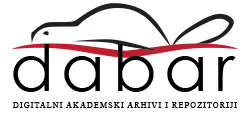Title Novi mediji u nastavi Prirode i društva Title (english) New media in teaching of Science Author Maja Mladenović Mentor Zdenko Braičić (mentor)Committee member Zdenko Braičić (predsjednik povjerenstva)Committee member Marina Đuranović (član povjerenstva)Committee member Irena Klasnić (član povjerenstva)Granter University of Zagreb Defense date and country 2020-06-29, Croatia Scientific / art field, NATURAL SCIENCES Scientific / art field, SOCIAL SCIENCES Abstract Živimo u vremenu svakodnevnog napretka tehnologije u poslovnom i privatnom životu, stoga je njezino uključivanje u obrazovanje i nastavni proces neizostavno. Današnja nastava i suvremena škola teže postavljanju učenika u središte nastavnog procesa, kao subjekta koji samostalno uz određene smjernice uči. U suvremenoj nastavi zadatak je učitelja da osposobe učenike za definiranje vlastitih ciljeva učenja, kako bi ovladali različitim strategijama učenja i upoznali kriterije kvalitete uspješnog učenja. Mediji su još iz prošlosti prisutni oko nas. Različiti autori, različito definiraju i dijele medije. Koncept multimedijske nastave datira još iz prošlosti, iako se na prvi pogled čini kao nov. Još je u 17. stoljeću, Jan Amos Komensky, prepoznao važnost medija u učenju i nastavi. Područje uporabe novih medija u nastavi i učenju je izrazito istraživačko područje te privlači pozornost istraživača od ranih početaka razvoja medija. Cilj je istraživanja ovog rada pridonijeti boljem poznavanju problematike uporabe novih medija u nastavi Prirode i društva. Istraživanjem se htjelo utvrditi jesu li škole dovoljno opremljene te pružaju li mogućnost za uporabu novih medija, kakav je stav učitelja o uporabi novih medija, jesu li učitelji dovoljno educirani za njihovo korištenje, što smatraju kao prednosti korištenja novih medija, što kao nedostatke te smatraju li da novi mediji u budućnosti mogu u potpunosti i na pravilan način zamijeniti tradicionalne medije. Istraživanje je pokazalo kako su učionice slabo opremljene novim medijima te kako učitelji pokušavaju naći sklad tradicionalnih i novih medija. Kao prednosti korištenja novih medija u nastavi Prirode i društva ispitanici ističu povećanje motivacije učenika, zorniji prikaz sadržaja, mogućnost približavanja izvorne stvarnosti te bolju vizualizaciju sadržaja. Kao glavni nedostatak korištenja novih medija većina ispitanika ističe smanjenje sposobnosti usmenog i pismenog izražavanja te tehničke probleme. Učitelji su još uvijek pristalice klasične nastave, jer smatraju kako „živu“ riječ učitelja niti jedan medij ne može zamijeniti.
Abstract (english) We live in the age of constant technological advances, using technology in both business and private life, which makes it indispensable in education and the teaching process. Today's education and contemporary schools tend to use student-centred learning where the student becomes a subject who, following certain guidelines, learns independently. In modern teaching, a teacher has a task to train students to define their own learning goals in order for them to master different learning strategies and learn the criteria of successful learning quality. The media has been around for ages. Different authors define and distinguish media differently. Although the concept of multimedia teaching may seem as something new at first glance, it has been present for a long time. Back in the 17th century, John Amos Comenius, recognized the importance of the media in teaching and learning processess. The field of use of the new media in teaching and learning process is a distinct research area that has attracked attention of researches ever since its beginnings. The aim of this thesis is to contribute to a better understanding of the use of the new media in the teaching of a school subject Science and Social Studies. The research aimed to determine whether schools are sufficiently equipped, whether they provide the opportunity to use the new media, what are the teachers' attitudes towards using them, are the teachers eduacated enough to use them, as well as to see what they consider to be advantages and disadvantages. The teachers were also asked whether they consider that the new media could completely and properly replace traditional media in the future. The research has shown that the classrooms were poorly equipped with the new media and that the teachers try to find harmony between traditional and new media. As advantages of using new media in the teaching of Science and Social Studies, the examinees pointed out the increase of students' motivation, a clearer presentation of the content, the possibility of approaching authentic reality and a better visualization of the content. As the main disadvantage of using new media, most of the examinees have pointed out the decrease in the ability of oral and written expression and technical difficulties. Teachers are still supporters of classical teaching because they believe that no media can replace the 'living' word of a teacher.
Keywords
mediji
novi mediji
razredna nastava
Priroda i društvo
stavovi učitelja
Keywords (english)
media
new media
classroom teaching
Science and Social Studies
teachers' attitudes
Language croatian URN:NBN urn:nbn:hr:147:962077 Study programme Title: Integrated Undergraduate and Graduate University Programme of Study of Primary Teacher Education and Integrated Undergraduate and Graduate University Programme of Study for Primary Teacher Education with English and German Language Type of resource Text File origin Born digital Access conditions Access restricted to students and staff of home institution Terms of use Created on 2020-07-13 08:22:09

